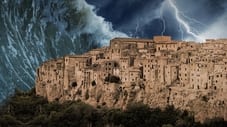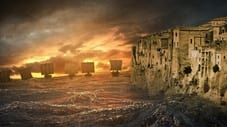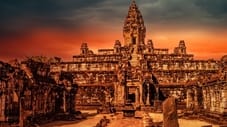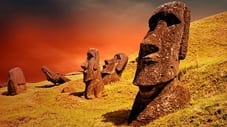
Ancient Apocalypse (2021)
← Back to main
Justin Rickett — Director
Episodes 8
Sodom and Gomorrah
The biblical story of Sodom. It’s stood for thousands of years as a powerful lesson of the perils of wickedness. According to the Bible, the men of Sodom were so wicked that God destroyed the city in a shower of fire and brimstone. But did the city of Sodom ever exist and could it be possible to locate? At Tall el-Hammam, in modern day Jordan, archaeologists have uncovered evidence of a once thriving bronze age city, destroyed by some cataclysmic event, that they believe is the city of Sodom.
Read MoreDoggerland
Eight thousand years ago, a lush paradise, home to mammoth, deer, and societies of hunter-gatherers connected Britain and mainland Europe - Doggerland. But this stone age Eden no longer exists. It was wiped out by a single devastating event, leaving it hidden beneath the waves of the North Sea for nearly 8,000 years. Slowly archaeology is revealing what life would have been like in this mesolithic paradise. But also how these people struggled to survive as their world was lost beneath the waves.
Read MoreThe Lost City of Helike
In 373 BCE the classical Greek city of Helike disappeared beneath the waves. Its destruction was so catastrophic that the only way the Greek authors could make sense of it was to blame it on the supernatural - Poseidon destroyed the city. It’s hauntingly similar to the myth of another Ancient civilization lost beneath the waves - Atlantis. Helike’s location is one of the greatest mysteries in archaeology, but could it be possible to rediscover the lost city and could Helike actually be Atlantis?
Read MoreAkkadian Empire
In 2334 BCE the Akkadians conquered and united the Sumerian city state kingdoms to create the world’s first empire. The Akkadian’s ruled over much of Mesopotamia, what is now modern day Iraq, Syria and Turkey, but after only 140 years the Akkadian Empire fractured. Entire regions of Mesopotamia descended into chaos and the Akkadian Empire’s very existence was lost to history. Now archaeologists scour the Middle East searching for information about how they became so powerful and why they collapsed.
Read MoreThe Mystery of the Sea People
In modern day Egypt, Syria, Turkey and Greece some of the greatest Bronze Age Civilizations rose to power. The Hittite Empire, the Mycenaeans, the all powerful Egyptian Empire. But in 1,200 BCE they imploded and the Bronze Age period of history collapsed. What, or who, was to blame? Evidence from across this region point to wave after wave of marauders invading from the sea right at the point the Bronze Age Collapse occurred. They’ve become known as the Sea People. Could they be responsible?
Read MoreThe Maya Civilization
Between 250 and 900 CE the Maya civilization built some of the most spectacular cities in history. They perfected mathematics, astronomy, architecture and the calendar. However, there was also a dark side — evidence of human sacrifices and war. But from around 900 CE the Maya’s luck ran out and their great cities were largely abandoned. Were their gods displeased? Archaeologists scour the jungles of Central America looking for clues to help explain the spectacular collapse of the Maya Civilization.
Read MoreThe Greenland Vikings
Led by Erik the Red, in 985 AD, an initial wave of Vikings from Scandinavia establish two successful outposts along the fjords of Southern Greenland – the ‘Eastern’ and ‘Western’ settlements. Numbering around 4,000 at their peak, they construct manor house and work the harsh terrain, to make it suitable for their European pastoralist life. They raise sheep, goats, and cattle; they trade furs, walrus-tusk ivory, and other arctic goods with Europe. For hundreds of years, they hold a quasi-monopoly on the European ivory trade, and almost all of it comes from walruses hunted by the Norsemen in Greenland. However, despite their commercial success, the Norse suddenly and mysteriously disappear from historical record at the start of the 15th century. The fate of the Norse will continue to bewilder archaeologists for centuries to come.
Read MoreThe Khmer
Founded at the beginning of the 9th century CE, the Khmer Empire had been one of the most powerful states in Southeast Asia, covering much of Cambodia, Thailand, Laos, and Southern Vietnam. The jewel in the crown was the capital city of the Khmer – Angkor – containing the largest religious structure ever built, Angkor Wat. The key to this growth was the Khmer mastery of rice cultivation and water management. Khmer cities were ‘hydraulic cities’, made up of complex systems of canals and reservoirs called ‘barays’, which steered water from the Khulen mountains to the plains of Angkor, ensuring a year-round supply for the population, agriculture, and livestock. Soon, however, the very factors that allowed the empire to rise lead to the abandonment of the Khmer’s magnificent temple-cities and their reclaim by the rainforest.
Read More






